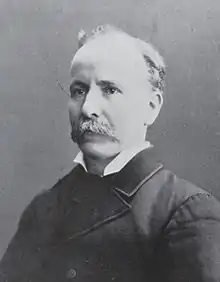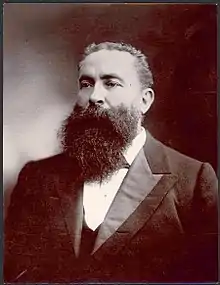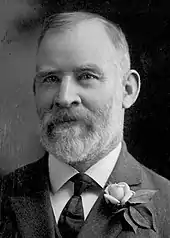Division of South Australia
The Division of South Australia was an Australian electoral division covering South Australia.[note 1] The seven-member statewide seat existed from the inaugural 1901 election until the 1903 election. Each elector cast seven votes. Unlike most of the other states, South Australia had not been split into individual single-member electorates. The other exception was the five-member Division of Tasmania. The statewide seats were abolished at a redistribution conducted two months prior to the 1903 election and were subsequently replaced with single-member divisions, one per displaced member, with each elector now casting a single vote.
| South Australia Australian House of Representatives Division | |
|---|---|
| Created | 1901 |
| Abolished | 1903 |
| Namesake | South Australia |
Members
Sorted in order of votes received
| Image | Member | Party | Term | Notes | |
|---|---|---|---|---|---|
 |
Charles Kingston (1850–1908) |
Protectionist | 30 March 1901 – 16 December 1903 |
Previously held the South Australian House of Assembly seat of West Adelaide. Served as minister under Barton. Transferred to the Division of Adelaide when South Australia was abolished in 1903 | |
 |
Sir Langdon Bonython (1848–1939) |
Protectionist | 30 March 1901 – 16 December 1903 |
Transferred to the Division of Barker when South Australia was abolished in 1903 | |
 |
Paddy Glynn (1855–1931) |
Free Trade | 30 March 1901 – 16 December 1903 |
Previously held the South Australian House of Assembly seat of North Adelaide. Transferred to the Division of Angas when South Australia was abolished in 1903 | |
.jpg.webp) |
(Sir) Frederick Holder (1850–1909) |
Free Trade | 30 March 1901 – 1903 |
Previously held the South Australian House of Assembly seat of Burra. Served as Speaker during the Barton and Deakin Governments. Transferred to the Division of Wakefield when South Australia was abolished in 1903 | |
| Independent | 1903 – 16 December 1903 | ||||
.jpg.webp) |
Lee Batchelor (1865–1911) |
Labour | 30 March 1901 – 16 December 1903 |
Previously held the South Australian House of Assembly seat of West Adelaide. Transferred to the Division of Boothby when South Australia was abolished in 1903 | |
 |
Vaiben Louis Solomon (1853–1908) |
Free Trade | 30 March 1901 – 16 December 1903 |
Previously held the South Australian House of Assembly seat of Northern Territory. Failed to win the Division of Boothby when South Australia was abolished in 1903. Later elected to the South Australian House of Assembly seat of Northern Territory in 1905 | |
 |
Alexander Poynton (1853–1935) |
Free Trade [lower-alpha 1] | 30 March 1901 – 1902 |
Previously held the South Australian House of Assembly seat of Flinders. Transferred to the Division of Grey when South Australia was abolished in 1903 | |
| Labour | 1902 – 16 December 1903 | ||||
- Though labelled a Free Trader, Poynton was an Australasian National League candidate.[1]
The Division was split into seven single-member seats at the 1903 election – Adelaide (Kingston, Protectionist), Angas (Glynn, Free Trade), Barker (Bonython, Protectionist), Boothby (Batchelor, Labour), Grey (Poynton, Labour), Hindmarsh (Hutchison, Labour) and Wakefield (Holder, Independent).
Election results
Elected members in bold. South Australia elected seven members, with each elector casting seven votes.
| Party | Candidate | Votes | % | ±% | |
|---|---|---|---|---|---|
| Protectionist | Charles Kingston | 41,477 | 65.9 | +65.9 | |
| Protectionist | Sir Langdon Bonython | 39,434 | 62.7 | +62.7 | |
| Free Trade | Paddy Glynn | 37,450 | 59.5 | +59.5 | |
| Free Trade | Frederick Holder | 37,424 | 59.5 | +59.5 | |
| Labour | Lee Batchelor | 31,614 | 50.3 | +50.3 | |
| Free Trade | Vaiben Louis Solomon | 27,030 | 43.0 | +43.0 | |
| Free Trade | Alexander Poynton | 25,864 | 41.1 | +41.1 | |
| Labour | Thomas Price | 24,019 | 38.2 | +38.2 | |
| Protectionist | Robert Caldwell | 21,102 | 33.6 | +33.6 | |
| Free Trade | Henry Baker | 15,760 | 25.1 | +25.1 | |
| Free Trade | Crawford Vaughan | 11,874 | 18.9 | +18.9 | |
| Free Trade | Richard Wood | 11,054 | 17.6 | +17.6 | |
| Free Trade | Thomas Webb | 9,357 | 14.9 | +14.9 | |
| Protectionist | John Cooke | 8,947 | 14.2 | +14.2 | |
| Protectionist | John O'Connell | 3,152 | 5.0 | +5.0 | |
| Protectionist | George Wyld | 2,858 | 4.6 | +4.6 | |
| Independent | George Mitchell | 1,745 | 2.8 | +2.8 | |
| Total formal votes | 350,161 | 98.4 | |||
| Informal votes | 985 | 1.6 | |||
| Turnout | 62,982 | 40.8 | |||
Notes
- The Northern Territory was part of South Australia until 1911. Its area was covered by the Division of Grey from 1903 to 1910.
References
- Van Den Hoorn, Rob. "Poynton, Alexander (1853–1935)". Australian Dictionary of Biography. Melbourne University Press. ISSN 1833-7538. Retrieved 29 July 2019 – via National Centre of Biography, Australian National University.